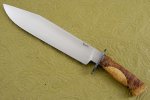Ok, so, you don't actually have to finish your handle to the grade that I do to pass your tests, but I'll share a few tips on that.
I was taught wood finishing by an ol' timer that worked for Benelli a long time ago and one of the most important things he stressed about finishing gunstocks was filling the grain. He really liked Teak Oil. I think we used SeaFin.
So, sand your handle down to 320-400 grit or so, saturate the handle with oil and let sit for about ten minutes while just keeping it wet so as much oil can soak in as possible. Then we would wet-sand so a slurry of sawdust fills the grains and pores. Kinda massage it in with your fingers too when it gets thicker. Let sit for 5 days or so in a warm room until that stuff is rock-hard. Sand back down to the wood again and do it again. Then sand it down to the wood yet again and this time, wipe off the slurry after wet-sanding and with a clean paper towel wipe on a clean coating of oil. Let dry. Repeat.
At this point the grain and pores are filled and you are building a very thin layer of hard, clean oil finish in and on the wood. Repeat the wet-sanding with 600, 800, 1200 grit papers. Apply clean oil everytime afterwards. Let dry completely. Buy some super fine steel-wool from Klingspore or Rockler (not Lowe's or Home Depot - their #0000 isn't the same.) Scrub the finish to a nice satin sheen. You can also rub-out the finish with Pumice then Rottenstone powders too.
So, that is how we did it and many, many of my sword handles/scabbards and knife handles were done this way. I'd recommend using Pro-Custom gunstock oil from Brownell's instead of Teak or Tru-Oil. And, yes, do this on stabilized woods too especially if you can see open grains like Koa, etc... You might want to use a buffer on the finish too, but if those grains/pores aren't filled, it won't look quite as nice as it can.
There are some other, quicker ways to fill the grain/pores too, but, you know - try this for a while...
Builds character.

